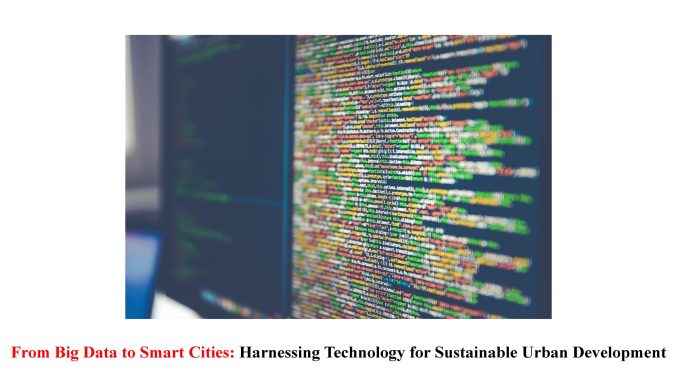
Introduction to Big Data and its Impact on Cities
Welcome to the era of Big Data and Smart Cities, where cutting-edge technology meets sustainable urban development! In today’s digital age, cities around the world are harnessing the power of data to revolutionize their infrastructure, improve the quality of life for residents, and create a greener future. From optimizing transportation systems to enhancing energy efficiency, the potential of smart city technology is truly awe-inspiring. So buckle up as we dive into this exciting journey from Big Data to Smart Cities and explore how it is shaping our urban landscapes in unimaginable ways!
The Role of Technology in Sustainable Urban Development
Technology plays a crucial role in driving sustainable urban development and creating smart cities. By harnessing the power of technology, cities can optimize their resources, improve efficiency, and enhance the quality of life for residents.
One key aspect is the use of data analytics to gather valuable insights from large volumes of information. Big data allows city authorities to make informed decisions based on real-time data, leading to more efficient resource allocation and better service delivery. For example, sensors placed throughout a city can collect data on energy usage, traffic patterns, air quality, and waste management. This information can then be analyzed to identify areas where improvements can be made.
Another important role that technology plays is in enabling effective communication between different stakeholders within a city ecosystem. Through mobile apps or online platforms, citizens can access information about public services such as transportation schedules or waste collection routes. This not only increases convenience but also promotes transparency and citizen engagement.
Furthermore, technology helps create smart infrastructure systems that optimize resource consumption while minimizing negative environmental impacts. For instance, using Internet of Things (IoT) devices connected through networks enables intelligent energy management by adjusting lighting levels based on occupancy or collecting rainwater for irrigation purposes.
In addition to these benefits, technology also facilitates the integration of renewable energy sources into urban grids. Smart grids enable efficient distribution and utilization of electricity generated from renewable sources like solar panels or wind turbines.
The role of technology in sustainable urban development cannot be underestimated. It has become an essential tool for improving efficiency across various sectors such as transportation systems, waste management processes, and energy consumption patterns.
Case Studies of Successful Smart City Initiatives
Case Study 1: Songdo, South Korea
One of the most notable examples of a successful smart city initiative is Songdo in South Korea. This planned city was built from scratch with technology at its core. It boasts an extensive sensor network that collects data on everything from traffic patterns to energy usage. By analyzing this data, city officials can make informed decisions to improve efficiency and sustainability.
Case Study 2: Barcelona, Spain
Barcelona has transformed itself into a leading smart city by leveraging technology to enhance various aspects of urban life. The city has implemented initiatives such as smart parking systems that guide drivers to available parking spaces, reducing congestion and emissions. Additionally, Barcelona uses sensors and analytics software to monitor air quality levels and automatically adjust traffic light timings accordingly.
Case Study 3: Copenhagen, Denmark
Copenhagen aims to become carbon-neutral by 2025 through its commitment to sustainable urban development. The city utilizes big data analysis for optimizing transportation systems and managing energy consumption efficiently. For instance, the intelligent bike-sharing system allows residents to easily find bikes using smartphone apps while also providing valuable information on cycling patterns for future infrastructure planning.
These case studies highlight how technology can transform cities into smarter and more sustainable environments. Through the use of big data analytics, these cities have been able to improve resource management, reduce environmental impact, and enhance the overall quality of life for their residents.
Harnessing technology in innovative ways like these successful initiatives showcases enormous potential benefits – streamlined transportation networks result in reduced congestion and improved air quality; optimized waste management leads to cost savings and reduced landfill waste; efficient energy usage reduces greenhouse gas emissions; enhanced public safety through advanced surveillance systems ensures citizens’ well-being.
While there are challenges associated with implementing smart city technologies such as privacy concerns or cybersecurity risks they can be addressable when approached thoughtfully ensuring citizen participation transparency governance structures robust security measures placing priority on protecting personal information and critical infrastructure safeguard against cyber threats
The future outlook for smart cities is promising as advancements in technology continue to emerge.
Potential Benefits of Implementing Smart City Technology
Smart city technology has the potential to revolutionize urban development and bring about a host of benefits for both residents and governments. One of the key advantages is improved efficiency in various aspects of city life, such as transportation, energy consumption, and waste management.
By harnessing big data analytics, smart cities can optimize traffic flow by identifying congestion points and suggesting alternative routes in real time. This not only reduces travel time for commuters but also decreases fuel consumption and air pollution. Additionally, sensors integrated into streetlights can detect when they are not needed, leading to significant energy savings.
Another benefit lies in the realm of public safety. Smart surveillance systems equipped with facial recognition capabilities can enhance security measures by quickly identifying individuals involved in criminal activities or locating missing persons. Moreover, using predictive analytics algorithms can help law enforcement agencies anticipate crime hotspots and allocate resources accordingly.
Furthermore, smart city technology promotes sustainability by enabling efficient use of resources. For instance, sensors can monitor water usage patterns across the city to identify leaks or areas where conservation efforts are needed. By addressing these issues promptly, cities can conserve water resources while reducing waste.
In terms of healthcare services, smart cities leverage technology to improve patient care through remote monitoring devices that enable doctors to track vital signs remotely. This enables early intervention and better management of chronic conditions while reducing hospital admissions.
Adopting smart city initiatives encourages citizen engagement by providing platforms for interaction between residents and local authorities. Through mobile applications or online portals, citizens have access to information on government services like garbage collection schedules or reporting infrastructure issues easily – fostering transparency and accountability.
Challenges and Concerns
As cities around the world embark on their journey towards becoming smart cities, they face various challenges and concerns that need to be addressed. One of the major challenges is data privacy and security. With the vast amount of data being generated by sensors, devices, and citizens themselves, there is a growing concern about how this data will be protected from unauthorized access or misuse.
Another challenge is ensuring equitable access to technology and digital infrastructure. While smart city initiatives have the potential to improve the quality of life for residents, there is a risk of creating a digital divide between those who have access to technology and those who do not. Efforts must be made to bridge this gap so that all citizens can benefit from these advancements.
Additionally, interoperability among different systems and technologies poses a challenge. Smart cities rely on multiple interconnected systems such as transportation, energy management, waste management, etc., which may be developed by different vendors using different standards. Ensuring seamless integration and compatibility among these systems requires careful planning and coordination.
Furthermore, cost considerations play a significant role in implementing smart city initiatives. While the benefits are undoubtedly promising in terms of efficiency gains and improved sustainability, the initial investment required can be substantial. Cities need to carefully evaluate their budgetary constraints while considering long-term benefits.
Citizen engagement remains an important concern when it comes to smart city development. For these initiatives to truly succeed, citizens must be actively involved in decision-making processes related to urban development projects. Their input should inform the design and implementation of technology solutions so that they align with their needs and aspirations.
Addressing these challenges requires collaboration between governments, private sector entities, academia, and civil society organizations as well as active participation from citizens themselves. By working together towards overcoming these obstacles we can ensure that our future cities are not only technologically advanced but also sustainable and inclusive places for everyone.
Future Outlook: The Evolution of Smart Cities
As technology continues to advance at a rapid pace, the future of smart cities holds tremendous potential. With the increasing availability and utilization of big data, cities are poised to become even smarter and more sustainable in the years to come.
One key aspect that will shape the evolution of smart cities is connectivity. As more devices become connected through the Internet of Things (IoT), cities will have access to real-time data that can be utilized for various purposes including traffic management, energy efficiency, waste management, and public safety.
Another important factor in the future outlook of smart cities is sustainability. With growing concerns about climate change and resource depletion, there is a pressing need for cities to adopt sustainable practices. Smart city technology can play a crucial role in achieving this by promoting energy-efficient buildings, intelligent transportation systems, renewable energy sources, and optimized resource allocation.
Furthermore, artificial intelligence (AI) will likely play an integral part in shaping the future of smart cities. AI-powered systems can automate processes such as predictive maintenance for infrastructure or optimize urban planning based on data analysis. This has the potential to greatly enhance efficiency and improve the quality of life for city residents.
Additionally, citizen engagement will continue to be a significant driver in shaping smart city initiatives. By involving citizens in decision-making processes and leveraging their input through digital platforms or community-driven projects, smart cities can ensure that technological advancements align with actual needs and preferences.
However, along with these exciting possibilities come challenges that need to be addressed proactively. Concerns over data privacy and security must be carefully managed to ensure citizen trust in these technologies remains intact. Additionally, equitable access should be ensured so that all citizens benefit from these advancements rather than exacerbating existing inequalities.
Conclusion: Why Investing in Smart City Technology is Crucial for Future Urban Development
Investing in smart city technology is not just a luxury or an option for the future, but a crucial step towards sustainable urban development. The potential benefits are immense – from improving efficiency and reducing resource consumption to enhancing public safety and quality of life.
By harnessing the power of big data and leveraging innovative technologies, cities can become more connected, responsive, and resilient. Through case studies like Singapore’s Smart Nation initiative or Barcelona’s implementation of IoT sensors throughout the city, we have seen how these efforts can transform urban spaces into smarter, greener, and more livable environments.
However, it is important to acknowledge that some challenges and concerns need to be addressed along this journey. Issues surrounding data privacy, cybersecurity risks, affordability for all residents, and equitable access to technology must be carefully considered.
Looking ahead, the evolution of smart cities will continue as advancements in technology open up new possibilities. From integrating renewable energy sources into the grid to utilizing artificial intelligence for predictive analysis in urban planning – the potential is truly limitless.
In conclusion (without using those exact words), embracing big data-driven solutions and investing in smart city technology is no longer a choice but a necessity if we want our cities to thrive in the face of rapid urbanization and environmental challenges. It requires collaboration between governments, businesses, communities, and citizens themselves.
As we move forward on this path towards sustainable urban development through technological innovation, let us remember that it is not just about making our cities “smarter”, but about creating inclusive, livable spaces where everyone has equal opportunities for growth and well-being.
Together, we can build better cities for a better future.



Leave a Reply